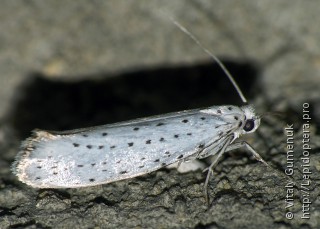Yponomeuta evonymella (Linnaeus, 1758)

Taxonomy
class Insecta → subclass Pterygota → infraclass Neoptera → superorder Holometabola → order Lepidoptera → superfamily Yponomeutoidea → family Yponomeutidae → subfamily Yponomeutinae → genus Yponomeuta → species Yponomeuta evonymella
Species name(s)
Yponomeuta evonymella (Linnaeus, 1758) = Yponomeuta evonymellus = Phalaena evonymella Linnaeus, 1758 = Hyponomeuta padi Zeller, 1844. [9, 10, 85]
urn:lsid:insecta.pro:taxonomy:11707
Expansion
This species marks on the maps: 3.
Zoogeographical regions
Palaearctic.
Russia regions
#1. Kaliningradsky; #2. Kolsky; #3. Karelsky; #4. Evropeisky Severo-Zapadny; #6. Evropeisky Severo-Vostochny; #7. Evropeisky yuzhno-tayozhny; #8. Evropeisky Tsentralny; #10. Sredne-Volzhsky; #11. Volgo-Donsky; #12. Nizhnevolzhsky; #13. Zapadno-Kavkazsky; #16. Sredne-Uralsky; #17. Yuzhno-Uralsky; #19. Sredneobsky; #20. Yuzhno-Zapadnosibirsky; #22. Krasnoyarsky; #26. Predbaikalsky; #27. Pribaikalsky; #28. Zabaikalsky; #29. Zapadno-Yakutsky; #31. Yuzhno-Yakutsky; #36. Sredne-Amursky; #37. Nizhne-Amursky; #38. Sakhalin; #39. Yuzhno-Kurilsky; #40. Primorsky.
Forewing length
10—13 mm.
Wingspan
16—25 mm.
Primary colors
Brown/Gray/Black, White.
Flight time
| January | February | March | April | May | June | July | August | September | October | November | December |
Larva lifespan
| January | February | March | April | May | June | July | August | September | October | November | December |
Over-wintering stage
Larva.

Detailed information with references
Taxonomy, synonyms and combinations
- Yponomeuta evonymellus. [5].
Distribution
- Austria, Belgium, Bulgaria, Great Britain, Hungary, Germany, Denmark, Greece, Ireland, Italy, Latvia, Lithuania, Luxembourg, Netherlands, Norway, Poland, Romania, Sicily, Slovakia, the Soviet Union - the European part, Finland, France, Czech Republic Switzerland, Sweden, Estonia, Yugoslavia. [1].
- Austria, Belarus, Belgium, Bulgaria, the British Isles, France, Germany, Gibraltar, Greece (mainland), Denmark (mainland), Ireland, Spain (mainland), Italy (mainland), Corsica, Latvia, Liechtenstein, Lithuania Luxembourg, Malta, Netherlands, Norway (mainland), the Channel Islands, Poland,Portugal (mainland), Russia, Romania, Northern Ireland, Sicily, Slovakia, Finland, France (mainland), Czech Republic, Switzerland, Sweden, Estonia. [10].
- Regions of the Russian Federation: the Volga-Don, the European North-East, the European North-West, the European Central European South taiga, Transbaikalia, Western Caucasus, Western Yakutia, Kaliningrad, Karelia, Kola, Krasnoyarsk, Nizhny-Amur, Lower Volga, of Baikal , Pribaikalskiy, Primorye, Sakhalin,Mid-Amur, the Volga-Average, Average Urals, Sredneobskaya, South West Siberian Yuzhno-Kuril, South Ural, South Yakutia. [3].
- Almost all of Europe. [5].
Imago Habitus and Differences from alike species
- Length of front wing is in the range of 1-1.3 cm, its color is silvery-white, with five longitudinal rows of black dots. Hind wings brown, with dark borders, they are shorter and wider than the front. Threadlike antennae length about 2/3 of the wing. At rest, the wings of the moth are rolled and pressed to the body. [5].
General info about Imago
- Moths fly in the floodplain forests along streams, in gardens and parks. Disturbed ermine moth bounce away and fall to the ground. [5].
Imago lifespan
- Early July - mid-August. [5].
General info about Larva
- Newly hatched gusenichka inactive, they have no extra concerns for winter bud scales. The larvae begin to feed in the spring, when they begin to blossom buds and young shoots appear. Young caterpillars are kept in groups, criss-crossing web of escape, and thus obtaining a common nest.If there are nests in the tree will be a lot, by the middle of May, the entire plant can be overgrown by silvery buildings ermine moths larvae, the web can envelop not only the branch, but the trunk to the ground. Track Yponomeuta evonymella inedible because of the substances that they learn when feeding on bird cherry.Pupation takes place in a dense cocoon, which is in general a nest located on a tree trunk or, much more rarely, in the grass. The first pupate most powerful and large caterpillars, later they are joined by those smaller in the end in a nest can collect up to hundreds of tracks, and the last, very small is not the place.Such nedokormyshi die, but not in vain - to the death, they envelop the entire web of neighbors that can identify, thereby contributing to their survival. [5].
Larva food plants / other food objects
- Typically, wild cherry Prunus padus. Very rarely - cherry and buckthorn. Moth eats only spring shoots. Actually, it may not consume the any other, because caterpillars are active only in the spring, the second generation of summer does not happen.As a result, often new, neobedaemye on bird cherry leaves can appear only after pupation and the emergence of adults of bird cherry ermine moths, ie late enough to be uninteresting for most other insects.And, although with a strong breeding butterflies tree may lose flowers, each year this horror is not repeated, because in the case of spring frosts killed most of gusenichek, providing a break for breeding bird cherry. [5].
Larva lifespan
- After wintering live until the end of May - beginning of June. [5].
Egg
- Eggs are laid on the wintering buds cherry. [5].
Overwintering stage
- Young caterpillars overwinter on buds. [5].
Authors
Initial species uploading to the site: Peter Khramov.
Photos:
Vitaly Gumenuk, Dina Rogatnykh. Text data: Peter Khramov.
The species characteristics formalization: Peter Khramov, Sergei Kotov, Vasiliy Feoktistov.
References
- [1] O. Karsholt, J. Razowski (eds.), 1996. The Lepidoptera of Europe: a distributional checklist
- [3] Каталог чешуекрылых (Lepidoptera) России. Под ред. С. Ю. Синёва. СПб.; М.: Товарищество научных изданий КМК, 2008
- [5] Райххолф-Рим Х. Бабочки. М.: Астрель, 2002
- [9] Tree of Life (funet.fi), 2012
- [10] de Jong, Y.S.D.M. (ed.) (2011) Fauna Europaea version 2.4 (faunaeur.org)
- [85] Lepidoptera species catalogue, Lepidoptera.ru, 2015
Comments
Note: you should have a Insecta.pro account to upload new topics and comments. Please, create an account or log in to add comments
Yponomeuta evonymella photos
Other species Yponomeuta






































